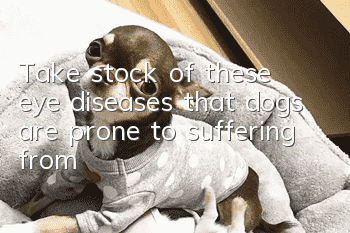Take stock of these eye diseases that dogs are prone to suffering from

We often say that eyes are the windows to the soul. In fact, eyes are very important to us. Without eyes, the world will become dark. However, many owners do not pay attention to the care of their dogs' eyes, which leads to eye diseases. So, what are the eye diseases that dogs are susceptible to?
1. Eye worm
Eye worms are white bugs that live in the eyes of dogs. They damage the conjunctiva and cornea, cause inflammation, and stimulate tear secretion. It is more serious when secondary bacterial infection occurs.
Dogs often become extremely restless after being infected, rubbing their eyes against other objects, shaking their heads, and losing appetite.
Damage the conjunctiva and cornea of animals, causing conjunctivitis and keratitis, and stimulating tear secretion.
If you find that your dog's eyes are flushed, tearful, often rubbing its eyes on other objects, shaking its head and other symptoms, you need to seek medical attention immediately.
2. Cataract
A dog's eyes suddenly become dull, dim, and cloudy. It bumps into furniture when walking, and appears hesitant when jumping up and down. This may be because of cataracts.
Due to aging, trauma, long-term eye inflammation or genetic problems in dogs, the lens metabolism is disordered. The light is blocked by the turbid lens and cannot be projected on the retina. After the disease, the dog's vision is very blurred, and it is also accompanied by tears. .
Decreased vision, double vision or black shadows, which may even lead to blindness in severe cases.
The progression of the disease can be slowed down by using intramuscular eye drops such as Binaide and Shezhu Eye Drops, and surgery is a more effective treatment method.
3. Keratitis
The cornea is located at the front of the eyeball. It is in direct contact with the outside world and is susceptible to damage by microorganisms, trauma, etc., causing inflammation. Dogs suffering from the disease may have blurred vision, pain, fear of light, and tears. If not treated in time, it may cause ulcers or even affect vision.
In the early stage of the disease, there will be tears, pain, red conjunctiva, and inability to open the eyes.
A turbid film appears on the cornea, accompanied by ulcers, purulent eye secretions, etc., resulting in severe visual impairment.
4. Eyelid ectropion
Eyelid ectropion is an abnormal condition in which the eyelid margin turns outward away from the eyeball. In mild cases, only the eyelid margins leave the eyeball, but the capillary action between the eyelids and the eyeball is destroyed, causing the dog to often shed tears. In severe cases, the entire palpebral conjunctiva of the dog is exposed.
Due to eye discomfort, dogs will often scratch, which will aggravate the ectropion.
Symptoms of epiphora appear to varying degrees. At the same time, dogs will sometimes suffer from eye discomfort.Frequent scratching movements aggravate the valgus.
Because the exposed conjunctiva loses the moisture of tears, it is initially locally congested and secretions increase, and eventually becomes dry and rough.
5. Abnormal eyelash growth
Trichiasis means that the dog’s eyelashes do not grow along the outside of the eye, but one or two lashes grow into the eye, which always irritates the eyeballs and causes constant tears.
This situation needs to be treated through surgery, which is somewhat similar to human double eyelid surgery. After the surgery, the problem of dogs always crying can be completely solved.
Sick dogs often shed tears, their eyes are afraid of light, they blink frequently, their conjunctiva is congested, and their eye secretions increase.
Dogs often scratch their eyes and often show restlessness or irritability.
- How to protect your dog’s food? Teach you tips on training your dog
- What should I do if my dog has lupus? Immune system diseases should not be underestimated
- Do dogs need deworming in summer? What should you pay attention to when raising dogs in summer?
- What to do if your dog has indigestion? Dog indigestion is no small matter!
- What should you pay attention to when vaccinating your dog? What should you pay attention to when vaccinating your dog?
- Symptoms of Rheumatism in Dogs What conditions can cause rheumatism in dogs?
- What to do if dogs fight at home? The owner is the best mediator
- What are the reasons why dogs are obese? Do you know these four reasons?
- The Disadvantages of Dogs Eating Leftovers Stop Feeding Your Dog Leftovers
- Symptoms of protein deficiency in dogs How to supplement protein



